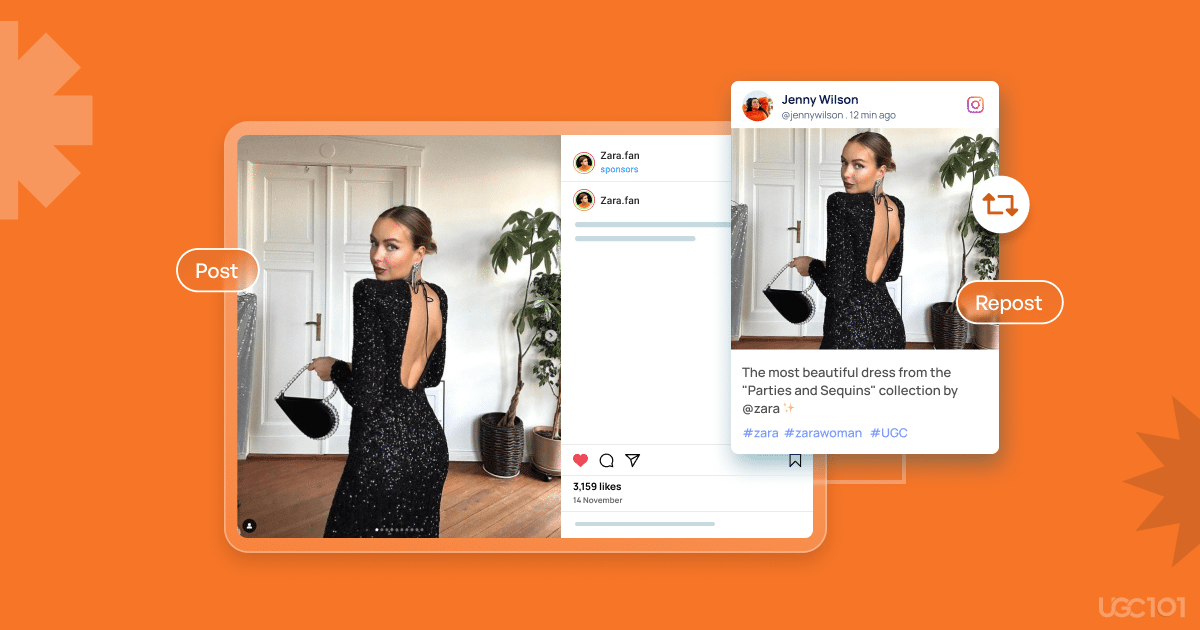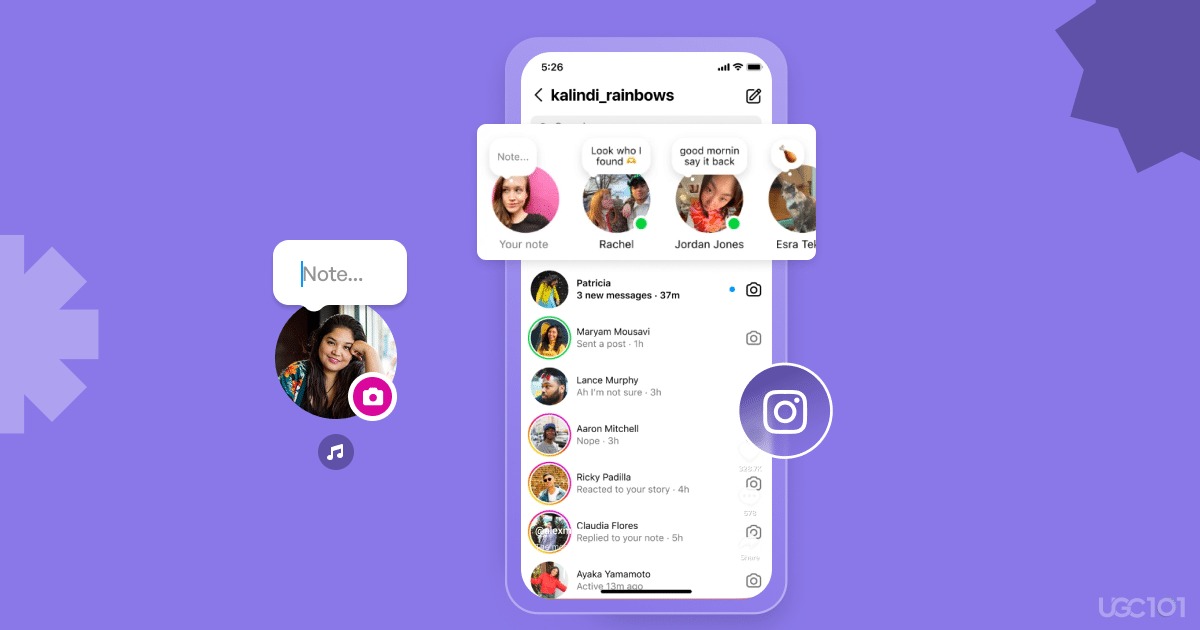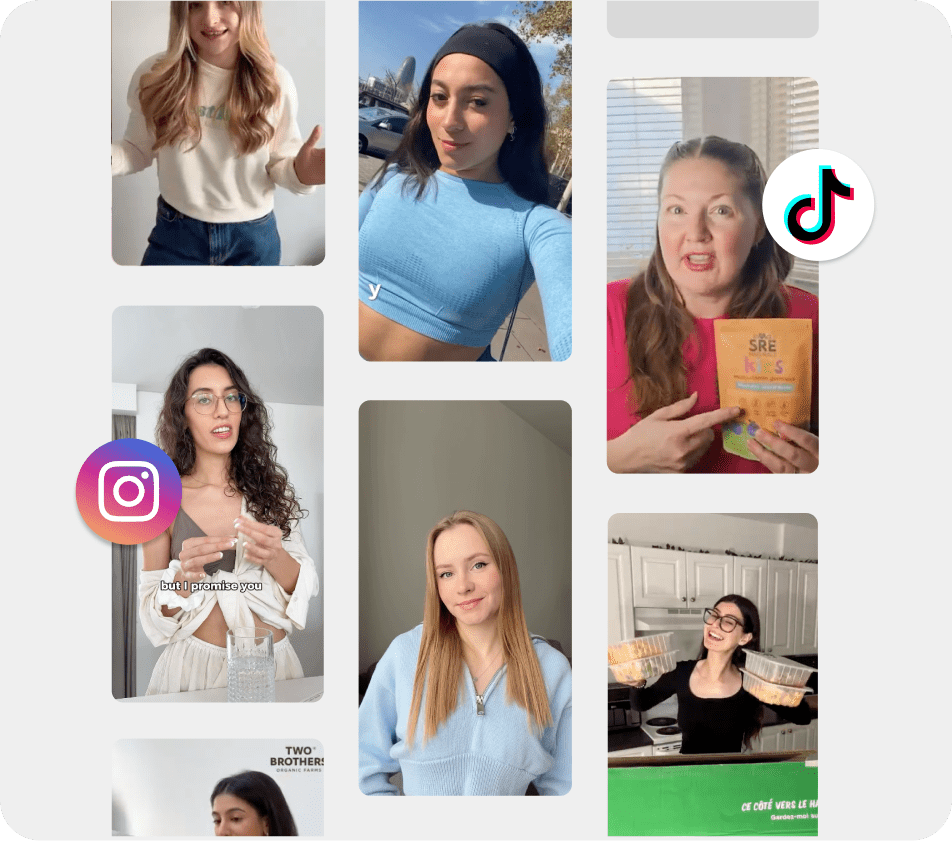I am tired of brainstorming social media strategies every month, keeping track of the trends, and looking for influencers to collaborate with, and so are you. Well, good for us; regramming (or reposting on Instagram) is here to save the day. It means exactly what it sounds like: reposting already published UGC on social media, with credits, of course!
Let’s dig in more.
What is Regram or Reposting on Instagram?
Regramming or reposting on Instagram refers to sharing someone else’s post on your Instagram feed or story. It involves taking content—usually in the form of an image, video, or a carousel post—from another user’s account and sharing it on your profile, either with or without modifications, while crediting the UGC creator.
This practice is prevalent across social media platforms, especially on Instagram, where users share content they find interesting, inspiring, or relevant to their audience. It’s a way to showcase content from others, express appreciation, collaborate with UGC Creators, and diversify your feed with various perspectives and content types.
Regramming is often done using built-in Instagram features like the “Repost” option in Stories or manually by taking a screenshot of the content and then sharing it with credit to the original creator in the caption or through tags. It’s important to note that while regramming fosters community engagement and content sharing, it’s crucial to respect the original creator’s rights and seek permission or give proper credit when sharing their content.
Why Repost on Instagram?
Reposting on Instagram brings a bundle of benefits:
1. Content Variety: Spice up your feed with diverse perspectives and engaging content that might resonate better with your audience than what you create yourself.
2. Community Engagement: It’s a conversation starter! Reposting encourages interaction, dialogue, and a sense of community by sharing and discussing content from various sources.
3. Acknowledgment: It’s a digital pat on the back for the creators whose work you admire. Reposting gives credit where it’s due and shows appreciation.
4. Curation: Become a curator of cool stuff! Reposting allows you to assemble a collection of remarkable content that aligns with your brand or interests.
5. Showcasing Partnerships: It’s a two-way street. Reposting collaborations or content from other brands or creators can strengthen relationships and expand your reach.
6. Trend Participation: Stay on top of the game by riding the wave of trends. Reposting viral or trending content keeps your profile relevant and engaging.
7. Amplify Reach: Your content might reach further when others share it. By reposting, you open the door for broader exposure.
8. Inspiration Source: It’s a goldmine for fresh ideas! Reposting can spark inspiration for your content strategy, helping you stay innovative and creative.
How to Repost on Instagram with Different Methods
Various methods you can use to repost on Instagram:
Method 1. Using Instagram Reposting Feature
1. Navigate to the post, Reel, or video you wish to repost on your profile.
2. Look for the airplane symbol (airplane icon) located below or beside the post. It’s usually used for sharing.
3. Click the airplane symbol. This will bring up a pop-up menu with various options.
4. Select “Add post to your story” from the menu. This will open the selected post within your Instagram Story editor.
5. Once in the Story editor, you can customize the reposted content. Tap to show or hide the original post’s caption, as you prefer.
6. Add your personal touch! Include text, stickers, hashtags, and other elements to complement or enhance the post.
7. When you’re ready to share, click “Your Story” at the bottom of the screen. This will publish the post to your Instagram Story.
8. If you want to keep the shared post for future reference or visibility, add it to your Highlights. This allows viewers to access this Story even after the standard 24-hour Story cycle.
Reposting through Instagram’s built-in feature is straightforward and allows for some customization before sharing the content on your Story, offering your audience a more engaging and personalized experience.
Method 2. Repost on Instagram Using a Screenshot
1. Find the photo on Instagram that you want to repost. Once you’ve found it, take a screenshot of the post using your phone.
2. On your Instagram profile, tap the “new post” button (it typically looks like a plus sign or a camera icon) to create a new post.
3. Select the screenshot you captured. The app will open it in the post editor.
4. Resize the screenshot within the app to fit Instagram’s post dimensions or your preferred size. This ensures the image looks good and fits your feed nicely.
5. Apply filters or edits if you wish to enhance the image. You can use Instagram’s built-in photo editing tools to adjust brightness contrast or add filters for that extra pop.
6. It’s crucial to give credit! Add the source of the post in the caption. This could be the username of the person who originally shared the content.
7. Craft a caption to accompany the reposted content. It could be your thoughts about the post or something that adds value to your audience.
8. Once everything looks good and you’ve credited the source, click “Share” to publish the post on your profile.
Reposting through a screenshot allows you to share content that might not have a direct reposting feature available. However, it’s essential to always credit the original creator and ensure the content aligns with Instagram’s community guidelines and copyright policies.
Method 3. Use a UGC Rights Management Tool
- Tagbox:
Tagbox is the ultimate UGC rights management tool that helps users collect, manage, and acquire rights for user-generated content. It allows you to moderate content, seek permissions, and display UGC on your website or social media platforms. With Tagbox, you can track and manage the rights associated with each piece of UGC efficiently.
- TINT:
TINT allows its users to aggregate user-generated content from various social media platforms. It provides tools for moderation, curation, and rights management. TINT also offers features to display UGC videos on websites, digital displays, or other marketing channels, ensuring compliance with rights and permissions.
- Pixlee:
Pixlee is another UGC marketing platform that helps brands collect, manage, and leverage user-generated content. It allows for aggregating content, obtaining rights and permissions, and integrating UGC into campaigns across different channels. Pixlee offers tools to streamline acquiring legal rights for using UGC.
- CrowdRiff:
CrowdRiff is a UGC platform that assists in discovering, managing, and obtaining rights for user-generated content. It provides tools for content curation, rights management, and integrating UGC into marketing strategies. CrowdRiff streamlines the process of seeking and managing permissions to use UGC legally.
These UGC rights management tools streamline the process of collecting, organizing, and legally using user-generated content. They often offer features for requesting permissions, managing rights, curating content, and integrating UGC seamlessly into marketing strategies while ensuring compliance with copyright laws and permissions from original creators.
Best Practices for Regramming
1. Be Thoughtful when Asking for Permission to Repost:
When seeking permission to repost someone’s content, ensure your request is polite and considerate. Clearly state your intention and how you plan to use the content, and express gratitude for the opportunity. Respect their decision if they decline.
2. Avoid Edits:
Maintaining the integrity of the original content is essential. Avoid editing the image or video significantly without the creator’s consent. This includes refraining from cropping, modifying, or adding elements that could distort the original meaning or context.
3. Credit the Original Source:
Always give credit where it’s due! Tag or mention the original creator prominently in your caption or within the post itself. Providing proper attribution acknowledges the creator’s work and allows your audience to discover and engage with the original content.
By following these best practices, you respect the original creator’s work and build a positive relationship within the Instagram community, fostering trust and authenticity in your regramming efforts.
7 Inspiring Examples of Global Brands Regramming
1. GoPro:
GoPro is renowned for regramming stunning user-generated content that showcases its product’s capabilities. They often feature extreme sports, adventure, and breathtaking landscapes captured by their customers, effectively building a community around their brand.
2. Behance:
As a platform that celebrates creativity, Behance often programs exceptional art and design pieces from its users. They spotlight diverse and innovative artworks, showcasing the talent of their community members.
3. Quince:
Quince, known for its luxury-grade essentials at affordable prices, often reposts customer photos featuring its products. They leverage user-generated content to showcase the versatility and quality of their items through real-life usage.
4. Nike:
Nike is adept at regramming content that aligns with its brand values of athleticism, determination, and empowerment. They share user-generated content depicting individuals achieving fitness goals or showcasing their Nike gear in action.
5. Zara:
Zara has utilized regramming to feature diverse styles and fashion statements customers wear worldwide. By regramming user-generated content, they create a relatable and inclusive brand image.
These brands leverage regramming to create community, authenticity, and engagement around their products or services. They use user-generated content to highlight diverse experiences, styles, and stories, effectively strengthening their brand identity and connection with their audience.
Conclusion
Regramming, the art of sharing captivating content on Instagram, unveils a world of possibilities for individuals and brands. From showcasing diverse perspectives to fostering community engagement, regramming fuels creativity and connectivity within the Instagram realm.
Whether utilizing Instagram’s built-in features for seamless sharing or employing manual methods like screenshots, reposting celebrates content diversity and collaboration.
Moreover, UGC rights management tools streamline the ethical use of shared content. Regramming transforms the platform into a space for authentic expression and engagement by following best practices and drawing inspiration from global brands.
Embracing the ‘Regram Revolution’ amplifies content variety and cultivates vibrant connections within the thriving Instagram community.
FAQs
Reposting on Instagram can be legal if you have permission from the original content creator or if the content falls under fair use. However, it’s essential to respect copyright laws and always give proper credit to the original creator when reposting.
There are multiple ways to repost on Instagram:
1. Use Instagram’s built-in reposting feature in Stories.
2. Manually repost by sharing a screenshot, ensuring to credit the original creator in the caption.
3. Utilize third-party apps designed for reposting content.
To repost a post on Instagram:
1. Use the Instagram app’s reposting feature by clicking the airplane symbol, selecting “Add post to your story,” and customizing it in your Story editor.
2. Alternatively, take a screenshot of the post, create a new post on your profile, upload the screenshot, add the source in the caption, and share it.
When you repost on Instagram, the content from the original post is shared on your profile or Story, allowing your followers to see it. Before sharing, you can add your commentary, stickers, or edits to the reposted content.



